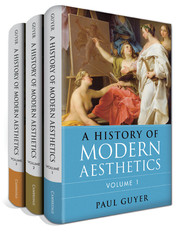Book contents
- Volume 1 The Eighteenth Century
- Volume 2 The Nineteenth Century
- Volume 3 The Twentieth Century
- Frontmatter
- Contents
- Acknowledgments
- Introduction
- Part One German Aesthetics in the Twentieth Century
- Part Two Aesthetics in Britain until World War II
- Part Three American Aesthetics in the First Half of the Twentieth Century
- Part Four Wittgenstein and After
- Bibliography
Part Two - Aesthetics in Britain until World War II
from Volume 3 - The Twentieth Century
Published online by Cambridge University Press: 05 June 2015
- Volume 1 The Eighteenth Century
- Volume 2 The Nineteenth Century
- Volume 3 The Twentieth Century
- Frontmatter
- Contents
- Acknowledgments
- Introduction
- Part One German Aesthetics in the Twentieth Century
- Part Two Aesthetics in Britain until World War II
- Part Three American Aesthetics in the First Half of the Twentieth Century
- Part Four Wittgenstein and After
- Bibliography
Summary
This part will first discuss aesthetics in Britain from the turn of the twentieth century to the outbreak of World War I, with the exception of Bernard Bosanquet’s 1915 Lectures, which have previously been discussed in conjunction with his History of Æsthetic published in 1892. It might therefore be a surprise that the name of the Italian Benedetto Croce is included in the title of its first chapter. But in spite of Croce’s indubitable centrality in the history of Italian philosophy, he will be considered here because of his enormous influence in Anglophone, especially British, aesthetics in the first part of the twentieth century. As we will see in the second and third chapters of this part, British aestheticians in the 1920s and 1930s responded far more to Croce’s version of idealism in aesthetics than to the more homegrown idealism of Bosanquet. Indeed, were we concerned solely with the background in the prewar years to what would happen in the 1920s and 1930s, we could confine this chapter to Croce. But the Anglicization of Croce, if we may call it that, was not the only thing that happened in aesthetics in prewar Britain. The tradition of aestheticism was carried on by the art critic Clive Bell, one of the central figures of “Bloomsbury,” the artistic and intellectual movement centered around the two daughters of Sir Leslie Stephen, Virginia Wolff and her sister Vanessa Bell, the wife of Clive Bell, after it so to speak passed through the crucible of the philosophy of G.E. Moore, the Cambridge professor who inspired many of the Bloomsburians. The name of Clive Bell is in turn almost always linked with that of another art critic, Roger Fry, who introduced Bell to the style of painting that they dubbed “Post-Impressionism” and organized several exhibits with him, but it will be argued here that their aesthetic theories need to be more carefully distinguished than they usually are, Fry’s being more comprehensive than Bell’s highly reductive approach to the aesthetic.
- Type
- Chapter
- Information
- A History of Modern Aesthetics , pp. 105 - 107Publisher: Cambridge University PressPrint publication year: 2014



